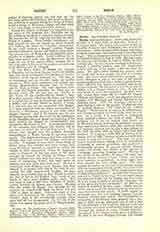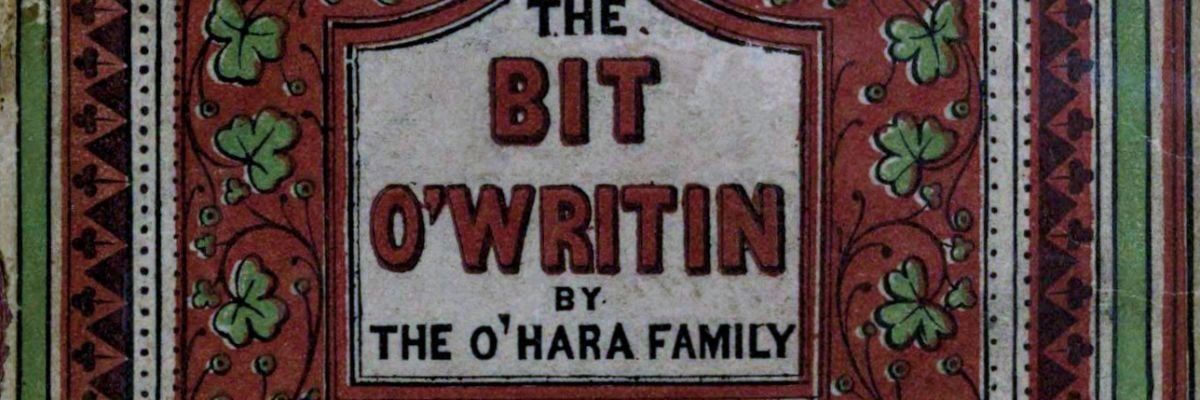

Banim, JOHN and MICHAEL.—JOHN, poet, dramatist, novelist, b. April 3, 1798, at Kilkenny, Ireland; d. August 31, 1842. His father, following the double occupation of farmer and storekeeper, was in easy circumstances. John’s literary efforts began very early; at ten he wrote some verses and a tale of considerable length. After a preparatory training in private schools he entered Kilkenny College in 1810. Having a taste for painting and drawing he went to Dublin in 1813 to study art. In two years he was back in Kilkenny, became a drawing teacher, and fell desperately in love with one of his pupils, a girl two years his junior. The girl’s father refused his consent, with the result that in two months she died of a broken heart. Her lover almost followed her example. An entire disregard of self at the time of the funeral caused paralysis and left him a victim of spinal disease, which afflicted him almost incessantly and finally caused his death. At the end of a year he set out for Dublin with a literary career in view. It was not long before he made his reputation. In 1821, when only twenty-three years old, he wrote the tragedy “Damon and Pythias”, which was played at Covent Garden with Macready and Charles Kemble in the principal parts. After his marriage, which took place during a visit to his parents, he planned with his brother Michael, “The Tales of the O’Hara Family“. These were to be written in collaboration, each brother to submit his work to the other for revision. As a result, it is impossible to distinguish from internal evidence the work of each. Their ambition was to do for Ireland what Scott, by his Waverley Novels, had done for Scotland—to make their countrymen known with their national traits and national customs and to give a true picture of the Irish character with its bright lights and deep shadows. To London, a wider field for literary work, Banim went in 1822 “without friends and with little money to seek his fortune”. The next ten years were a fruitful season, during which he contributed frequently to various periodicals, and produced a considerable number of operatic pieces, dramas, essays, and novels, but always at the expense of “wringing, agonizing, burning pain”. Writing of this period to his brother, he says: “Of more than twenty known volumes I have written, and treble their quantity in periodicals, no three pages have been penned free from bodily pain”. The little crumbs of comfort he received he generously shared with his countryman, Gerald Griffin, who wrote of his early struggles in London: “What would I have done if I had not found Banim?” In 1829 John Banim was ordered to France in the hope that he might repair his shattered health, but the journey was of no avail. In a few years a stroke of paralysis “deprived him of the use of his limbs and brains”. In 1835 he returned to Kilkenny by slow stages. Dublin and his native city showed him signal honor by demonstrations that moved him deeply. A public appeal for assistance met with such generous response that his financial troubles were ended. The Government, in recognition of his literary work, granted him a pension of £150, and an additional sum of £40 a year for the education of his daughter. His last work was the revision of a story which he had inspired and encouraged his brother to write, “Father Connell”, the picture of his beloved parish priest of Kilkenny. He died in his own Windgap Cottage, just outside Kilkenny, at the early age of forty-four. His principal works are: the poems, “Soggarth Aroon”, “Ailleen”, “The Celt’s Paradise”; the dramas, “Damon and Pythias” and “The Prodigal”; and the novels, “John Doe”, “The Fetches”, “Peter of the Castle”, “The Mayor of Windgap”, and “The Boyne Water”, the last a political novel.
MICHAEL, novelist, and co-worker with his brother John, b. at Kilkenny, Ireland, August 5, 1796; d. August 30, 1874. At sixteen he began the study of law, but soon abandoned it because of business reverses which befell his father. He took upon himself his father’s burden and reestablished his parents in comfortable circumstances. The little leisure his business cares allowed him he made the most of by gathering material for “The Tales of the O’Hara Family“. At the urgent request of John, he contributed several of the stories, his first, “Crohoore of the Billhook”, being perhaps the most popular of all. But Michael generously kept himself in the back-ground in order to let his younger brother have all the honor of their joint production. Out of twenty-four volumes he wrote thirteen. Unlike John, however, he was a man of action, and threw himself earnestly into various movements for the uplifting of his countrymen, educationally and economically. After serving for many years as postmaster of Kilkenny, he died at the age of seventy-eight at Booterstown, not far from Dublin. The principal works of Michael Banim are: “Crohoore of the Billhook”, “The Ghost Hunter”, “Father Connell”, and “The Croppy”, a tale of 1798.
The Banims may be justly called the first national novelists of Ireland. They knew their countrymen not as the strange, grotesque caricatures too often portrayed in fiction, but as members of the great human family with noble impulses and generous traits. Their work, however, is notably free from patriotic bias. Their Irishmen have their faults. Though naturally sympathetic, tenderhearted, and forgiving, these typical Celts could become stern, bitter, and revengeful. Ignorance, poverty, and cruelty are shown to exist among the peasantry. But the reader cannot fail to see the cause of all this—the natural working out of religious persecution and political oppression. Criticism has been directed against some of their writings as “harrowing”, and “impure”. The latter criticism is unfortunately justified; John admitted and regretted it, and Michael acted on it by preventing one of the stories, “The Nowlans”, from being reprinted. As to the “harrowing” elements, which are certainly conspicuous, the brothers answered: “We paint from a people of a land among whom, for the last six centuries, national provocations have never ceased to keep alive the strongest and often the worst passions of our nature”. It may be added that, besides their desire to give a true picture of their country, still crippled and prostrate from the effects of the Penal Laws, they were undoubtedly influenced by the Romantic movement, then at its height. A recent edition of the works of the Banims, in ten volumes, which gives a life of John Banim, appeared in New York, 1896.
M.J. FLAHERTY


